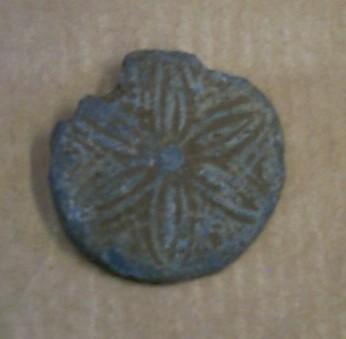button
Production date
1662
Description
Lead alloy button 26mm in diameter and 3mm thick. The shank is missing and there is some damage to the edges. The button bears a sexfoil flower on a field of geometric decoration, a design known from a number of uniface stone button moulds which have survived from the late medieval and early post-medieval period. Unlike these simpler examples this button has been cast in a three piece mould with an integral shank (now missing) and bears on the back the maker’s mark ‘DM’ and the date 1662.
Although a relatively mundane artefact this find is a useful illustration of dress style and contemporary artisinal production. The button has much in common with the class of lead alloy seal matrices made in Scotland in the late 16th to mid 17th centuries, again pieces produced in a three piece mould.
References: Caldwell D H (1993) Lead seal matrices of the 16th and early 17th century PSAS 123
See full details
Object detail
Dimensions:0 - Whole:D 0.3cm (D 1/8")
TREASURE TROVE ARTEFACT REPORT
Artefact:Lead alloy button Period/Culture:Post-medieval Date:17th century Glossary definition:Button
Findspot: Larbert House NGR:
Town: Larbert LAA: Falkirk
Method of discovery: metal detecting
Finder: Mr Colin Irvine
Artefact description and report materials: lead alloy dimensions: Th 3mm; Dia 26mmcondition: shank missing, some damage to edgescompleteness: incomplete Although a relatively mundane artefact this find is a useful illustration of dress style and contemporary artisinal production. The button bears a sexfoil flower on a field of geometric decoration, a design known from a number of uniface stone button moulds which have survived from the late medieval and early post-medieval period. Unlike these simpler examples this button has been cast in a three piece mould with an integral shank (now missing) and bears on the back the maker’s mark ‘DM’ and the date 1662. In this sense the button has much in common with the class of lead alloy seal matrices made in Scotland in the late 16th to mid 17th centuries, again pieces produced in a three piece mould.References: Caldwell D H (1993) Lead seal matrices of the 16th and early 17th century PSAS 123
Report by: Stuart Campbell
Digital photographs © Crown Office
TTAP date: 18 February 2005
Museum:
Valuation: £20
dwelling house
ha-ha
designed landscape


Public comments
Be the first to comment on this object record.